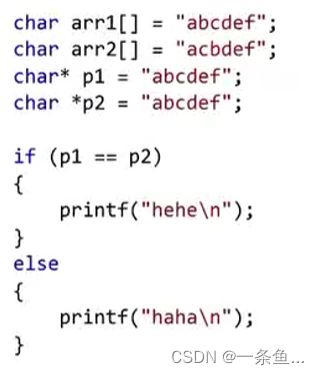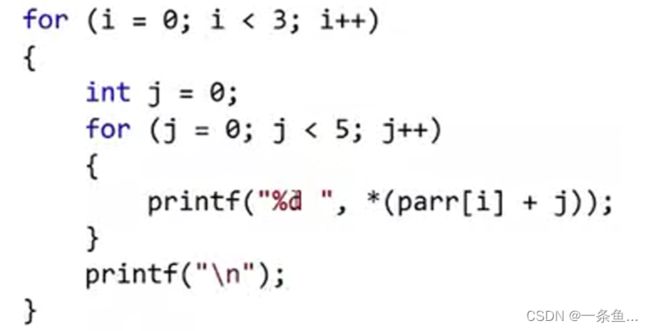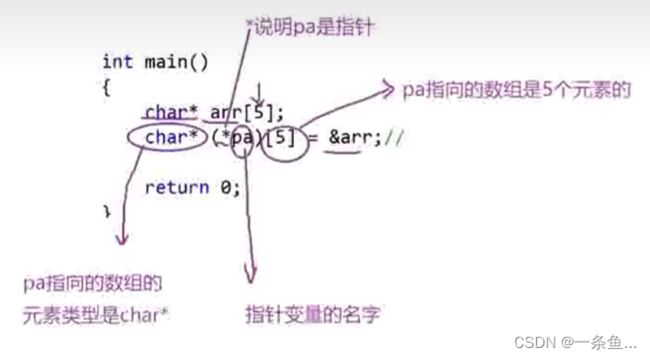c语言,进阶指针
一.字符指针
字符类型指针char*
注意:因为char* ptr="abcdef"是一个字符串常量,所以在不同编译器前可能需要加上const
例题:
左边结果是haha,右边是hehe;因为p1和p2指向的字符串是常量字符串,不需要二次创建地址;
二.指针数组
顾名思义:数组的元素是指针;
能否根据指针数组parr输出arr1中的元素数据呢->of course
当i=0时;parr[0]是arr1的首元素地址,再加上j,就表示arr1数组中第一个元素向右的偏移量,依次逐个输出arr1的元素;同理arr2和arr3中元素也可以输出
三.数组指针
数组指针是什么->答案是指针;
数组指针就是指向整个数组的指针
#include
int main(){
//int *p=NULL; //p是整型指针,指向整型的指针,可以存放整型的地址
//char *pc=NULL; //pc是字符指针,指向字符,可以存放字符的指针
//int arr[10]={0};
//arr首地址
//&arr数组地址
//int* ptr=arr;整型指针
int arr[10]={0};
int (*p)[10]=&arr; //p为数组指针
} 在这里注意:(个人理解),p是指向整个数组的指针,那么*p就表示数组名arr;
指针数组与数组指针辨别;
▲▲▲
- 指针数组:int *p1[10]; //p1与[号结合性高,p1[10]说明是一个数组,*p1[10]说明数组元素为指针,int *p[10]说明数组元素(指针)指向的是整型
- 数组指针:int (*p2)[10];//*p2说明p2是一个指针,(*p2)[10]说明指针p2指向一个元素个数为十的数组,int (*p2)[10]说明p2指向的数组的元素类型为int
深度理解:
char *arr[5];
char* (*pa)[5]char* (*pa)[5];说明p2指向数组的元素类型为char*
数组指针的使用
注意:*pa其实就等于arr;但这种打印方式费力且不讨好;
另一个示例:
#include
void print1(int arr[3][5],int x,int y){ //这里第一个形参中括号里面必须写上几行几列
for(int i=0;i 注意:arr[i]=*(arr+i)=*(p+i)=p[i];
在二维数组中:arr[0],arr[1],arr[2]表示的就是第几行的首地址
辨别与分析:
四.数组传参和指针传参
数组参数
一维数组传参:
三种接受方式;
#include
void test(int arr[]){}
void test(int arr[10]){}
void test(int *arr){}
void test2(int *arr[]){}
void test2(int *arr[20]){}
void test2(int **arr){}
int main(){
int arr[10]={0};
int *arr2[20]={0};
test(arr);
test2(arr2);
} 二维数组传参:
三种接收方式;
#include
void test(int arr[3][5]){} //列不可以省略
void test1(int arr[][5]){}
void test2(int (*arr)[5]){}
int main(){
int arr[3][5]={0};
test(arr);
test1(arr);
test2(arr);
} 指针传参:
一级指针传参:
二种传递方式;
#include
void test(int *p){}
void test1(char *p){}
int main(){
int a=10;
int *p1=&a;
test(&a);
test(p1);
char ch='w';
char *pc=&ch;
test1(&ch);
test1(pc);
} 二级指针传参:
三种传递方式;
#include
void test(int **p){}
int main(){
int n=10;
int *p=&n;
int **pp=&p;
test(pp);
test(&p);
int *arr[10];//指针数组,相当于传递的是二级指针pp
test(arr);
} 五.函数指针
首先要知道函数也有地址;
函数指针:是指向函数的指针-存放函数地址的一个指针
且&function与function取出来的地址一样,无差别;
#include
void Add(int x,int y){
printf("%d\n",x+y);
return 0;
}
int main(){
int a=10;
int b=20;
void (*p)(int x,int y)=Add; //函数指针
//p指向函数,*p表示函数名
//调用函数
(*p)(a,b);
} 注意:函数指针类型要与函数返回值类型一致
还要注意一点:这里用p(a,b)直接调用这个函数也是可以的,因为&arr=arr;
p=&arr=arr;同时因为p=&arr,所以*p=arr;所以调用函数这里*p与p表示的含义一样;
另外,使用*p调用时,需要加上括号
分析两个代码含义:
- (* (void(*)() ) 0 ) ();
- void( *signal(int,void(*)(int) ) ) (int)
六.指向函数指针数组的指针
函数指针数组
#include
int Add(int x, int y) {
return x + y;
}
int Sub(int x, int y) {
return x - y;
}
int Mul(int x, int y) {
return x * y;
}
int Div(int x, int y) {
return x / y;
}
int main() {
//指针数组
//int *arr[5]
//函数指针数组->需要一个数组,这个数组可以存放四个函数的地址
//int (*p)(int x, int y) = Add; //函数指针
int (*pa[4])(int x, int y) = { Add,Sub,Mul,Div };//函数指针数组
for (int i = 0; i < 4; i++) {
printf("%d ", pa[i](2, 3));
}
return 0;
} 函数指针数组辨析:
arr1里面多个],忽略忽略
函数指针数组案例:转移表
#include
int Add(int x, int y) {
return x + y;
}
int Sub(int x, int y) {
return x - y;
}
int Mul(int x, int y) {
return x * y;
}
int Div(int x, int y) {
return x / y;
}
void menu() {
printf("************************\n");
printf("**1.add 2.sub **\n");
printf("**3.mul 4.div **\n");
printf("** 0.exit **\n");
printf("************************\n");
}
int main() {
int input = 0;
int x = 0, y = 0;
int(*pa[5])(int, int) = { 0,Add,Sub,Mul,Div };
do {
menu();
printf("请选择:");
scanf_s("%d", &input);
if (input >= 1 && input <= 4) {
scanf_s("%d%d", &x, &y);
int ret = pa[input](x, y);
printf("%d\n", ret);
}
else if (input == 0) {
printf("退出\n");
}
else {
printf("选择错误\n");
}
} while (input);
} 利用函数指针数组,就可以根据input的值来调用需要的函数,如果没有函数指针数组,就要用switch case语句,相对而言,代码就冗长了
函数指针数组的指针
int Add(int x, int y) {
return x + y;
}
int main() {
int arr[10] = { 0 };
int (*p)[10] = &arr; //数组指针
int(*pf)(int, int) = Add;//函数指针
int (*pfarr[10])(int, int);//函数指针数组,数据类型int (*)(int,int)
int(*(*ppfarr)[10])(int, int) = &pfarr;//函数指针数组的指针
//指向数组的每个元素类型都是函数指针
//(*ppfarr)是个指针,指向元素个数为10的数组,数组元素类型:int (*)(int,int)
return 0;
}七.回调函数
实例一:
#include
int Add(int x, int y) {
return x + y;
}
int Sub(int x, int y) {
return x - y;
}
int Mul(int x, int y) {
return x * y;
}
int Div(int x, int y) {
return x / y;
}
void menu() {
printf("************************\n");
printf("**1.add 2.sub **\n");
printf("**3.mul 4.div **\n");
printf("** 0.exit **\n");
printf("************************\n");
}
void Calc(int(*p)(int, int)) {
int x = 0, y = 0;
printf("请输入两个数:");
scanf_s("%d%d", &x, &y);
printf("%d\n", p(x, y));
}
int main() {
int input = 0;
do {
menu();
printf("请选择:");
scanf_s("%d", &input);
switch (input) {
case 1:
Calc(Add);
break;
case 2:
Calc(Sub);
break;
case 3:
Calc(Mul);
break;
case 4:
Calc(Div);
break;
case 0:
printf("退出\n");
default:
printf("选择错误\n");
}
}
while (input);
} 其中Add,Sub,Mul,Div都是回调函数
实列二:
qsort函数的使用,头文件
#include
#include
#include
typedef struct{
const char *name;//在这里还可以用char name[20]
int age;
}Stu;
int cmp_by_name(const void *e1, const void *e2) {
//字符串比较用strcmp函数,头文件
return strcmp(((Stu *)e1)->name, ((Stu *)e2)->name);
}
int main() {
//利用qsort函数实现不同数据类型的冒泡排序
Stu s[3] = { {"张三",20},{"李四",30},{"王五",10} };
int sz = sizeof(s) / sizeof(s[0]);
//头文件
qsort(s, sz, sizeof(s[0]), cmp_by_name);
for (int i = 0; i < 3; i++) {
printf("name:%s age:%d\n", s[i].name, s[i].age);
}
return 0;
}
▲重点知识1:qsort函数的参数
▲重点知识2:函数cmp_by_name的参数,以及返回值类型表示的含义
▲重点知识3:strcmp函数的作用,以及返回值的类型 ,是按首字母降序排列:a,b,c……
▲重点知识4:void*指针类型的使用,以及强制类型转换的使用
▲▲重点知识5:char *name(字符型指针)与char name[](字符型数组)都可以保存字符串,不同的是char *name是保存字符串常量,故要把char *name转换成const char *name才可以使用
实例三:利用回调函数实现qsort函数
typedef struct {
char name[20];
int age;
}Stu;
int cmp_by_name(const void *e1, const void *e2) {
//字符串比较用strcmp函数,头文件
return strcmp(((Stu *)e1)->name, ((Stu *)e2)->name);
}
int cmp_int(const void *e1, const void *e2) {
return *(int*)e1 - *(int*)e2;
}
void Swap(char *buf1, char *buf2, int width) {
for (int i = 0; i < width; i++) {
char temp = *buf1;
*buf1 = *buf2;
*buf2 = temp;
buf1++;
buf2++;
}
}
void bubble_sort(void *base, int sz, int width, int(*cmp)(const void *e1, const void *e2)) {
for (int i = 0; i < sz - 1; i++) {
for (int j = 0; j < sz - 1 - i; j++) {
if (cmp((char*)base + j * width, (char*)base + (j + 1)*width) > 0) {
Swap((char*)base + j * width, (char*)base + (j + 1)*width, width);
}
}
}
}
void test1() {
int arr[10] = { 1,2,5,6,8,9,7,3,4,0 };
int sz = sizeof(arr) / sizeof(arr[0]);
bubble_sort(arr, sz, sizeof(arr[0]),cmp_int);
for (int i = 0; i < 10; i++) {
printf("%d ", arr[i]);
}
printf("\n");
}
void test2() {
Stu s[3] = { {"张三",20},{"李四",30},{"王五",10} };
int sz = sizeof(s) / sizeof(s[0]);
bubble_sort(s, sz, sizeof(s[0]), cmp_by_name);
for (int i = 0; i < 3; i++) {
printf("%s %d \n", s[i].name,s[i].age);
}
}
int main() {
test1();
test2();
} 










